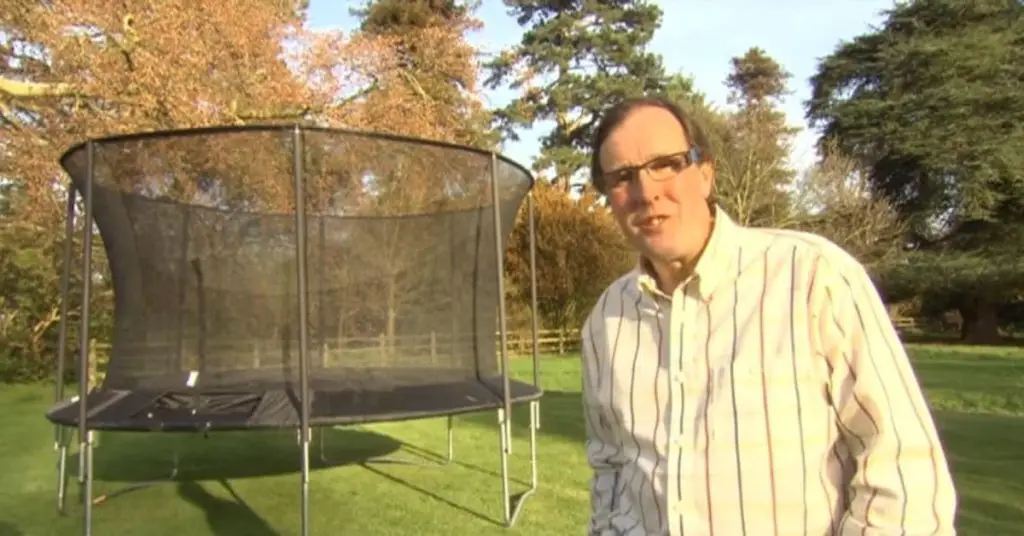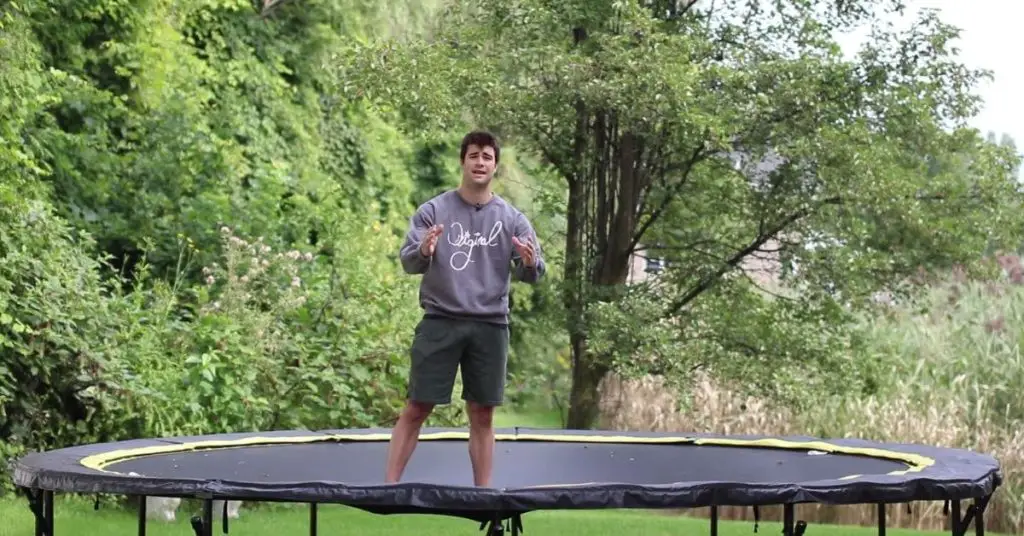When I’m out having a blast on my trampoline, keeping active and cheerful, I sometimes notice this black residue on the mat, especially since it’s getting on in years. It’s a bummer because it gets my feet all grimy.
So, I did a little digging to find out why is my trampoline turned my feet black. Turns out, there are a few culprits like accumulated dirt and gunk, as well as carbon buildup. But, hey, no need to fret!
It’s nothing some elbow grease and regular upkeep can’t handle. With a bit of cleaning and my trampoline will be as good as new!
Why Is My Trampoline Turn My Feet Black: My trampoline turns my feet black due to accumulated dirt, grime, and carbon buildup on the mat. A good scrub and regular maintenance can easily keep this issue at bay.
Why Is My Trampoline Turn My Feet Black?

If your feet turn black after jumping on a trampoline, it’s because of two things. First, the trampoline mat might be old, and the black stuff is like a soft, powdery material coming from the mat.
Second, the mat might just be dirty and needs cleaning. If it’s the powdery stuff, that means your trampoline is getting too old and it’s time to think about getting a new one.
What should you be Aware of Regarding Trampoline Mats?
In an ideal world, it would be amazing if everything could last forever, but unfortunately, that’s not the reality we live in. Everything we use and own eventually gets old and wears out over time.
Trampoline mats follow the same principle. They have a lifespan, just like the food you buy from the store. You can think of trampoline mats as being good for a certain period, but not indefinitely.
As they age, the materials they are made of begin to deteriorate, and this can lead to some unpleasant consequences.
When a trampoline mat reaches the end of its lifespan, strange things can happen. The materials inside the mat may start to break down, causing them to release residue or particles that can create a mess.
These black residues or particles can stick to your feet and make them dirty when you jump on the trampoline.
It’s important to remember that trampoline mats, like many other products, have a limited lifespan. Taking care of your trampoline, performing regular maintenance, and being aware of the signs of wear and tear can help ensure you have a safe and enjoyable jumping experience while minimizing any unwanted residue or mess.
Trampoline Black Feet and Their Causes
Trampoline black feet can happen for various reasons, but it usually boils down to two main culprits: carbon buildup and plain old dirt.
Grime and Dirt:
The air around us is full of tiny bits and pieces. When cars and trucks drive on roads, the roads break down a little and make small particles. Bits of rubber from tires also dry up and float in the air.
This stuff eventually falls down and becomes dirt. There are also tiny pieces from nature like dead bugs, mud, leaves, and stuff from flowers that break apart and float in the air too.
These bits also land and stick to things. Also, sometimes yucky, sticky stuff from fires, like soot and ash, or even from factories, can land on stuff like trampoline mats.
A Jumping Mat’s Carbon:
The part of the trampoline you jump on is usually made of a special fabric called polypropylene. It’s supposed to stand up to sunlight, but nothing lasts forever, especially if it’s always in the sun.
After a while, the sun’s rays start messing up the mat and the protective layer on top, making the black stuff inside come out. Also, if the trampoline has been used a lot, the mat might have tiny rips.
Using it a bunch, along with stuff from the air and even sweat from people jumping, will make the mat get old and worn out.
More Reasons Trampoline Can Make Feet Black:
Sometimes, the chemicals in the cleaners don’t get along with the mat and make it fall apart, letting out black stuff.
Also, how you clean matters. Scrubbing with a tough brush is a no-go. It’s better to use a soft cloth to gently wipe the mat.
Tips to Prevent Trampoline Black Feet
To ensure the safety and longevity of your trampoline, it’s important to take necessary precautions to protect it from various weather conditions. Here are some detailed steps you can follow:
- Find a shady spot when setting it up: Select an area in your yard that offers shade for your trampoline. Placing it under a tree or in a spot that receives less direct sunlight can help prevent excessive exposure to UV rays, which can deteriorate the trampoline’s materials over time.
- Clean it often: Regular cleaning is crucial to maintain the trampoline’s condition. Use a broom or brush to remove leaves, dirt, and debris from the mat, frame, and springs. This will prevent accumulation and potential damage caused by these elements.
- Use a cover to shield it from bad weather: Invest in a trampoline cover specifically designed to fit your trampoline’s dimensions. Covering the trampoline when not in use will protect it from rain, snow, sun, and other harsh weather conditions, reducing the risk of damage and prolonging its lifespan.
- Prepare it for the cold if not in use during winter: If you won’t be using the trampoline during winter, consider disassembling and storing it. Disassemble the frame, mat, and springs, and store them in a dry and sheltered location to prevent exposure to freezing temperatures, snow, and ice.
- Avoid placing hard or sharp objects near the trampoline: Keep the surrounding area clear of any hard or sharp objects such as furniture, tools, or toys that may pose a risk of puncturing or damaging the trampoline. This will help maintain its integrity and prevent accidents or injuries.
- Consider using special trampoline shoes: While not necessary, wearing special trampoline shoes can provide additional grip and protection while jumping.
These shoes are designed with non-marking soles to minimize the risk of damaging the trampoline mat. However, always ensure they are clean and free from debris before jumping.
By following these detailed steps, you can protect your trampoline from weather-related damage, keep it clean, and ensure a safe and enjoyable jumping experience for yourself and others.
Trampoline Cleanup Tips

Here’s a step-by-step guide to effectively clean the dirt off your trampoline:
- Sweep the mat with a long broom to remove loose dirt and debris.
- Prepare a bucket of warm, soapy water using around 2-3 tablespoons of dish detergent.
- Use a soft brush to gently scrub the trampoline with the soapy solution, focusing on areas with black residue.
- Rinse the trampoline thoroughly using a garden hose, ensuring all soap and dirt are washed away.
- Allow the trampoline to dry completely before using it for jumping or other activities.
By following these simple steps, you can keep your trampoline clean and ready for safe and enjoyable use.
Removing Trampoline Black Stains from Clothes
When the black residue is on your feet, it’s easy to clean after washing. But when it gets on your clothes, removing the stain can be tough. Here are some tips to help:
- Keep the stained clothes separate from other clean ones.
- Soak the cloth in a bucket of water with detergent overnight. Use about a cup of detergent.
- After soaking, you can clean the clothes by hand or in a washing machine.
If the stain is large and tough, it can be more challenging to clean. In such cases, you may need to use a washing spray with solvents. Let it sit on the stain for several hours, then scrub and clean the clothes.
What can I do to prevent my trampoline from causing black feet?
It’s not difficult to keep the black residue off your trampoline, but you need to avoid using cleaning products with chemicals. These can harm the trampoline.
Here are some things you can do to prevent your trampoline from turning your feet black:
- Get a trampoline cover to keep dirt, dust, and other stuff off the jumping surface.
- Place the trampoline in a shady spot to protect it from the sun.
- If you won’t use the trampoline for a while or during winter, store it away.
- Clean your trampoline regularly with soapy water.
- Consider using rubberized paint on the trampoline.
- Don’t bring any food or drinks onto the trampoline to avoid spills.
- Wear shoes with rubber soles or grippy socks (but be careful, shoes can cause static shocks in dry areas!).
How should I choose Appropriate Footwear for use on a Trampoline?
To avoid getting black marks on your feet from the trampoline mat, you should consider wearing specific types of footwear. However, it’s important to follow the instructions provided by the trampoline manufacturer and consider the quality of the mat material.
Here are some options for footwear on a trampoline:
- Rubber-soled shoes: Wear shoes with rubber soles to prevent black marks on your feet. Just make sure to check for any rocks stuck in the tread before jumping on the trampoline.
- Gymnastic slippers: These slippers are lightweight, flexible, and allow you to maintain control while jumping and performing tricks on the trampoline.
- Trampoline socks: Choose socks that are flexible and lightweight, similar to gymnastic slippers. These socks should provide enough grip to ensure you don’t lose control while jumping on the trampoline.
How should you handle a situation when the trampoline mat gets damaged or worn out?
When you notice that the trampoline is producing black marks or carbon, it means that the mat has deteriorated and needs to be replaced. Unfortunately, there is no way to fix this issue, as it is caused by the plastic material of the trampoline mat breaking down.
Prevention and Maintenance

Preventing and maintaining your trampoline can help ensure it stays in good condition and avoids causing black feet. Here are some tips:
Regular Cleaning and Maintenance Routine
- Properly clean the trampoline surface before use: Before each use, take the time to clean the trampoline surface. Use a broom or brush to remove any loose debris, such as leaves, twigs, or dirt. This will help prevent these materials from accumulating and causing stains or damage.
- Regularly remove debris and dirt from the mat: Make it a habit to regularly inspect and clean the trampoline mat. Use a soft brush or cloth to gently sweep or wipe away any dirt, dust, or residue that may have accumulated.
- This will help maintain the cleanliness of the mat and prevent the transfer of dirt to your feet.
- Ensure proper drainage to prevent moisture buildup: Check the trampoline’s drainage system to ensure that water can flow freely. If there are any blockages, clear them to prevent water from pooling on the mat.
- Moisture buildup can lead to mold, mildew, and deterioration of the mat, which can result in black residue.
Inspecting and Replacing Worn-Out Parts
- Check the trampoline mat for signs of wear and tear: Regularly inspect the trampoline mat for any signs of damage, such as holes, tears, or fraying edges.
If you notice any of these issues, it’s essential to address them promptly. Small tears can worsen over time, leading to larger damage and potential safety hazards.
- Replace the mat if it shows signs of deterioration: If the trampoline mat is significantly worn out, with extensive damage or weakened areas, it may be necessary to replace it.
A deteriorated mat can contribute to the accumulation of black residue and compromise the safety and performance of the trampoline.
Using Protective Footwear or Socks While Jumping
Consider wearing protective footwear or socks while using the trampoline. This can provide an additional barrier between your feet and the mat, minimizing direct contact with any residue or dirt that may be present. Choose shoes or socks with non-slip soles to ensure stability and grip while jumping.
By following these prevention and maintenance practices, you can keep your trampoline clean, functional, and enjoyable, reducing the chances of black residue on your feet.
Safety and Health Considerations

When using a trampoline, it’s important to prioritize safety and take certain health considerations into account. Here are some guidelines to keep in mind:
Importance of Maintaining a Clean and Hygienic Trampoline
Keeping your trampoline clean and hygienic is crucial for ensuring a safe and healthy jumping experience. Here’s why:
- Preventing the spread of bacteria and germs: Regularly cleaning the trampoline surface helps eliminate dirt, debris, and potentially harmful microorganisms. This reduces the risk of infections or illnesses that can be transmitted through contact.
- Maintaining optimal performance: A clean trampoline allows for better traction and grip, ensuring safer and more enjoyable jumping sessions. Dirt and residue on the mat can make it slippery, increasing the likelihood of slips, falls, or accidents.
- Prolonging the lifespan of the trampoline: Regular cleaning and maintenance help prevent the accumulation of dirt, grime, and corrosive substances on the trampoline. This extends its longevity, saving you from expensive repairs or the need for premature replacement.
Potential Health Risks Associated with Dirty Trampoline Surfaces
Neglecting proper cleaning and hygiene of your trampoline can lead to various health risks:
- Skin irritations and infections: Dirty trampoline surfaces can harbor bacteria, fungi, and other pathogens that may cause skin irritations, rashes, or infections upon contact.
- Allergies and respiratory issues: Accumulated dust, pollen, and other airborne particles on the trampoline can trigger allergies or respiratory problems, particularly for individuals with sensitivities or pre-existing conditions.
- Eye and ear infections: Contaminants on the trampoline surface can potentially enter the eyes or ears during jumps, increasing the risk of infections or irritation in these sensitive areas.
Benefits of Foot Protection During Trampoline Use
Using foot protection such as shoes or grippy socks offers several advantages:
- Enhanced Grip and Stability: Footwear with non-slip soles or grippy socks can provide better traction on the trampoline surface, reducing the risk of slipping or losing balance while jumping.
- Protection Against Injury: Foot protection can offer a layer of cushioning and shock absorption, reducing the impact on joints and feet during jumps. It can also protect against accidental contact with sharp objects that may be present on or around the trampoline.
- Hygiene and Cleanliness: Wearing foot protection can help prevent direct contact between feet and the trampoline surface, reducing the chances of picking up dirt, residue, or potential pathogens that may cause black stains or health issues.
By understanding and implementing these safety and health considerations, you can create a clean, hygienic, and safer trampolining environment for yourself and others.
FAQs:
Q:1 How can I remove the black residue from my trampoline?
First, use a broom to sweep off any dirt or debris from the trampoline. Then, either use a hose or fill a bucket with lukewarm water to spray the trampoline. Now it’s time to scrub!
Grab a sponge or a soft-bristled brush and apply some soap or a gentle detergent. Use this to clean the trampoline thoroughly.
Q:2 Can wearing shoes damage a trampoline?
Wearing shoes on a trampoline is not only dangerous but can also harm the mat. Shoes with heavy-duty soles or those designed for outdoor use can cause the jumping mat to wear out faster because of the increased friction.
It’s best to avoid wearing shoes on the trampoline to protect both yourself and the mat.
Q:3 What is the typical lifespan of a trampoline?
On average, a large outdoor trampoline can last anywhere from 3 to 8 years. The specific lifespan of different parts can vary. The mat typically lasts around 1 to 5 years, the frame lasts between 3 to 8 years, and the springs have a lifespan of around 3 to 4 years. However, there are trampolines, like those made by Acon, that are designed to last a lifetime.
Q:4 What should I use to clean my trampoline?
Get a bucket and fill it with warm, soapy water. Make sure to avoid using any harsh chemicals or strong cleaning products. Take a sponge or a soft cloth and gently wipe down the jump mat, removing any dirt or debris.
Avoid scrubbing too hard to prevent damage. Repeat the same process for the safety pads and PVC sleeves on the arms of the trampoline. If there are any muddy parts on the exposed frame, wipe them down as well.
Q:5 What are the reasons to avoid using soap and water on a trampoline?
It’s best to avoid using soaps that contain chemicals on the trampoline mat. These types of soaps can corrode the material and cause damage to the mat over time.
Conclusion:
In conclusion, if you find that your trampoline is turning your feet black, there are several potential reasons for this occurrence. One common cause is the accumulation of dirt, grime, and carbon residue on the mat, especially as the trampoline ages. This can happen due to regular use and exposure to the elements.
Another factor could be the breakdown of the trampoline mat’s protective layer under prolonged exposure to UV rays, leading to the release of black residue.
Additionally, the use of harsh cleaning agents or chemicals can contribute to the degradation of the mat and the appearance of black stains.
To prevent black feet, it is essential to maintain regular cleaning and maintenance routines, avoid using chemicals on the trampoline, consider the lifespan of different trampoline parts, and take precautions such as wearing proper footwear. By following these practices, you can enjoy a clean and safe trampolining experience.
We hope you will be well aware of why is my trampoline turn my feet black, after reading this comprehensive article. If you have any questions, feel free to comment below!

